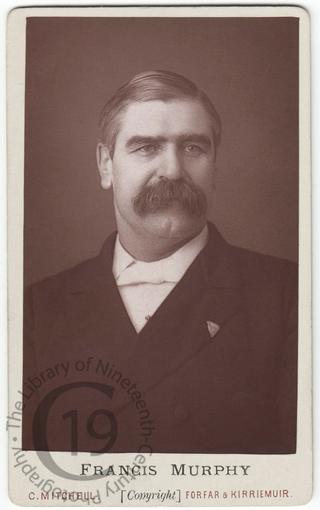
Francis Murphy
A carte-de-visite portrait of the American temperance evangelist Francis Murphy (1836-1907).
Born on 24 April 1836 at Tagoat in County Wexford, Ireland, Murphy immigrated to the United States when he was sixteen years old and served in the Union Army during the American Civil War. In 1870 he started a temperance movement that eventually attracted many millions of followers. Through his appearances at temperance meetings around the world he is said to have induced some 16 million people worldwide to take the pledge. He died in Los Angeles on 30 June 1907, following a long illness.
‘A Reuter’s telegram states that the death has taken place in Los Angeles, California, of Mr Francis Murphy, the well-known American Gospel Temperance advocate and founder of the Blue Ribbon movement. Born in county Wexford, Ireland, in 1836, he emigrated to American in his youth, and went through the Civil War. He then engaged in the hotel business in the city of Portland, and not without success, but soon he began to give way to drink and had to placed in an institution for inebriates. There he came under the influence of a certain Captain Sturdivant [sic], who changed the course of his life, and he resolved to devote himself to the cause of temperance.
‘It was at a great temperance meeting in Rhode Island that the first discovered his powers as a speaker. He set on foot the Gospel Temperance movement, which induced over ten million people to sign the pledge throughout the United States. In the midst of his work he accepted an invitation to pay a visit to this country, and met with extraordinary success. It was stated that in Forfarshire alone during a campaign of two months over 50,000 took the pledge and put on the Blue Ribbon.
‘Murphy lived the simplest of lives, and sought no public recognition outside his own work. He never allowed his oratory to carry him to excess in the denunciation of those against whose trade he warned the people’ (Lancashire Evening Post, 1 July 1907).
According to an obituary that appeared in the New York Times the same day: ‘Frances Murphy was considered one of the foremost temperance advocates of this generation. […] The temperance movement started by Mr Murphy spread rapidly from State to State, and in 1880 he campaigned in the northern part of California, making many converts to his cause. In 1881 he went to Europe, at the time of the Ecumenical Conference of the Methodist Church. So great was the interest in temperance that he campaigned for four years and obtained about 5,000,000 signatures to his pledge. When he returned to New York he was given a great reception in Cooper Union, which was followed by a series of receptions in Philadelphia and other cities, and in Pittsburg, where he lived for twenty-five years. […] Mr Murphy went to Honolulu in 1900 and held a great series of meetings there. He then went to Australia, where he was also very successful. In 1901 he returned to California, and made a tour of that State, and wound up in Los Angeles, where he had since made his home.’ (New York Times, 1 July 1907).
Photographed by C. Mitchell of Forfar in Scotland.
This is one of eight portraits of Murphy that Charles Mitchell entered at Stationers’ Hall – an essential part of the copyright process – between February and April 1882
Code: 127373




